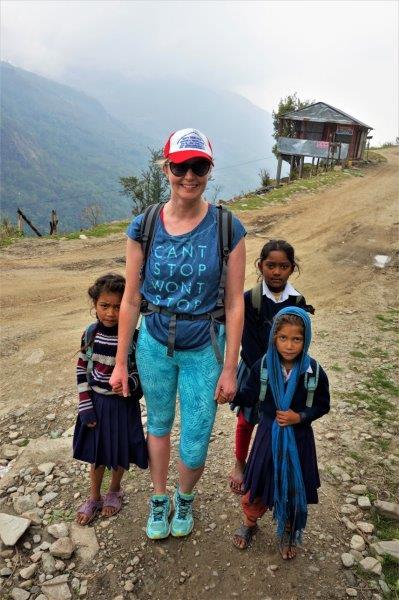I have always wanted to visit Nepal. My Grandparents used to host students that were studying at the English School in Christchurch. I distinctly remember a lovely Nepalese man playing games with my siblings and I. He was clearly missing his children, and spent a lot of time with us. Combined with a feeling that NZ and Nepal are linked via Sir Edmund Hillary, images of prayer flags rippling in the wind and great craggy peaks drew me in.
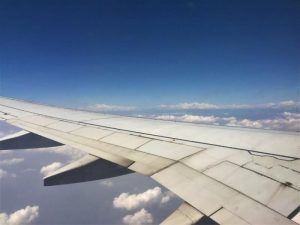
The flight from India was quick, and we were running ahead of schedule. As we flew over Nepal, the long braided rivers, hills, and valleys reminded me of New Zealand. The Himalayas rose into view, a mesmerising sight. Like grumpy old men, they stood gnarled and wrinkled, with fluffy white clouds for beards. We had to do a few laps before we landed, and as we circled, I noticed something I’ve never seen before on a flight- every single person was craning their necks to look out the windows, and no-one was talking.
Eventually we punched through the cloud, to view the dusty, boxy city of Kathmandu. We landed, disembarked, and I found my Air BnB. I scored another Air BnB victory and was staying with a family not far from the city, but far enough that traffic was a distant memory and the nights were peaceful. The people were gracious and charming, the food fantastic, and my trip was made infinitely easier and better because of them.
Things to do in Kathmandu
Thamel
Day one, I walked into Thamel, possibly the most famous of the things to do in Kathmandu. On the way, I purchased a local sim card so I had Google Maps, vital for me as I have no sense of direction (seriously, NO sense of direction).
The ancient streets are narrow and dusty, strewn with electrical cables hanging in great bird nests of wiring. Roads criss cross randomly, and intersections are uncontrolled, often with shrines and temples dotted throughout. These create pockets of traffic chaos, mini-roundabouts.
Kathmandu isn’t polluted, but it is very dusty. Many people wear dust masks, and I can understand why. I developed a cough after 24 hours, which disappeared when I reached the mountains.




Durbar Square
I headed into Durbar Square. This is where most temples are located, and the palace. Nepal’s earthquake in 2015 didn’t damage a lot in Katmandu itself, but many of the ancient buildings are now just a stack of bricks. It’s sad, but some are being rebuilt, and many tourist facilities have reopened.

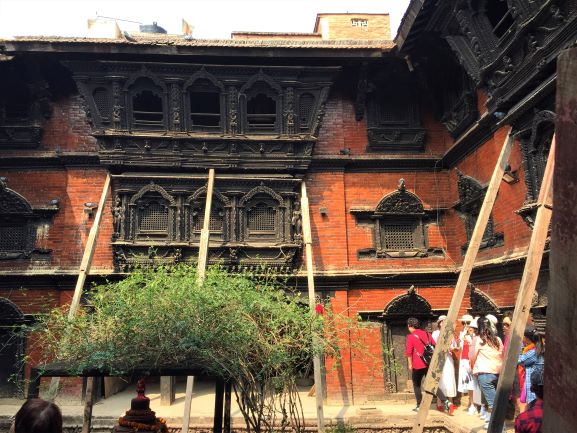
The building is home to the Kumari, a girl who is chosen to be a living goddess until she reaches puberty, where she returns to being a mortal. The goddess appears at the window and if you see her, it is supposed to bring good luck. She happened to be there when I was there… Good luck the building didn’t fall on me I guess.
Garden of Dreams
I wandered off to the Garden of Dreams. A pocket of green, a lush oasis in the tooting chaos. I had a beautiful (expensive) meal here with yak cheese and buffalo mozzarella salad (cheese heaven).

Narayanhiti Palace
I walked through the Narayanhiti Palace. I wasn’t allowed to take photos, but it’s where all the Nepalese Royals lived until 2006, when the Royals were given 15 days to vacate following the revolution. It has largely stayed the same since; with CRT TV’s gathering dust in all their 1990’s glory. A faded threadbare attempt at opulence. It was interesting though. One 1 June, 2001, there was a royal massacre. Ten members of the family were killed during a party. There are theories that the massacre was an inside job, that it was due to a marriage disagreement. The room that the massacre happened in was demolished VERY quickly after the killings, supporting this theory. There are still bullet holes visible on the back of the palace wall.
Swayambhu Stupa Swayambhunath (Monkey Temple)
I then walked to Swayambhu Stupa Swayambhunath (Monkey Temple). There was a walk to the top and then I got a little click-happy… excuse all the photos….







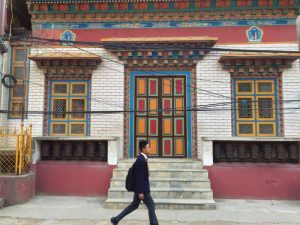
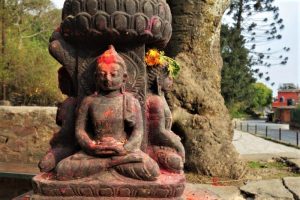
The next day, following my host’s suggestion, I walked around the edge of Kathmandu, halfway up the hill. Popped into a monastery and then walked into town.

Pashupatinath Temple for cremations
I then taxied over the other side of town, to Pashupatinath Temple. This is where there are a multitude of Hindu temples. It’s crawling with goats, cows, pigeons, monkeys, and people. Everywhere you look, there are people carrying out a variety of different religious ceremonies. Burning things, talking to holy men, praying… an interesting place to people watch.

I then headed down to the Bagmati River. This is where Hindu death rites and cremations happen. I thought it was going to be macabre. It wasn’t. It was actually peaceful (as much as it ever gets in Kathmandu), respectful, and gentle.
The dead are placed on stretchers and carried to the riverside. Family and friends place them on the banks of the river, stripped them of their clothes, wash them, and anoint them with various powders and preparations. It varies from caste to caste and sect to sect, but it’s all carried out with gentle respect and love. In the instance of one of the cremations I watched, the sons prepared him. They had their heads shaved except for a small ponytail-esque spot on the back of their heads. Once this has been completed, the dead are carried to a pyre, placed on it, and the pyres are lit. It was a simple ceremony and I found it quite beautiful.


That night, I met a friend. We went to a quiz night in a local pizza restaurant. Had a team with an Aussie, Canadian, American, an Indian/ Nepalese, and myself. We lost badly, as per most quiz nights I attend.
I was sad to leave; I had discovered so many things to do in Kathmandu, but I had a bus ticket and a place to be…


